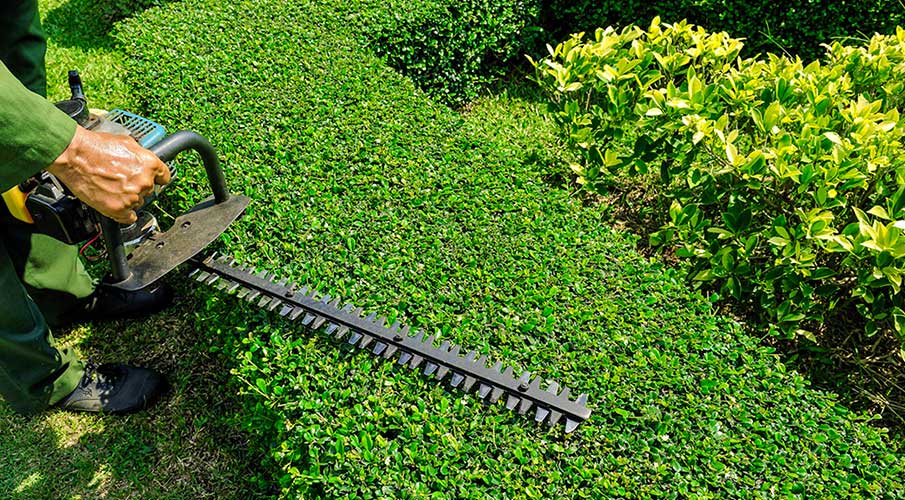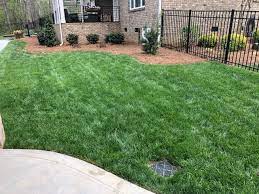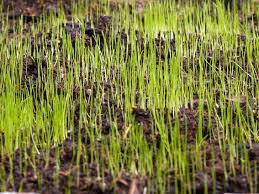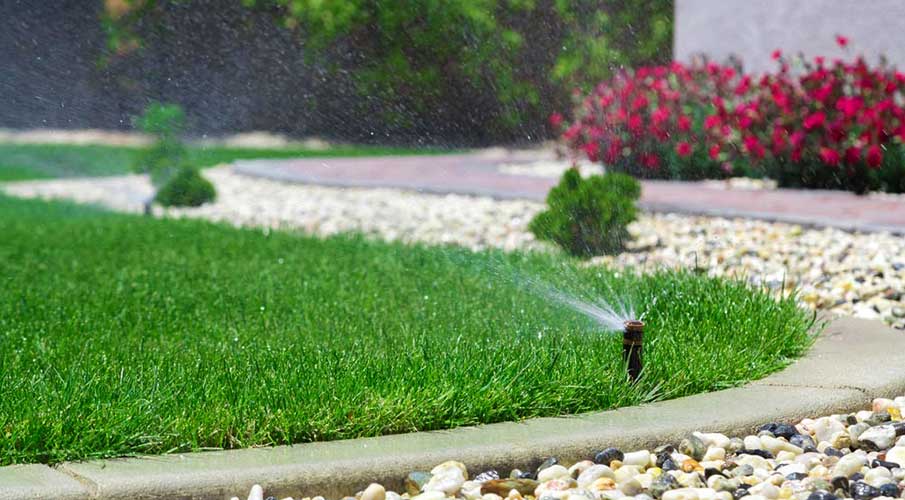In this article, I’ll go over the best grub killer options, including application timing, the grub life cycle, how to diagnose a grub infestation, and a step-by-step guide for applying a granular imidacloprid product.
Why Kill the Grubs?
As a lawn care professional, I know how frustrating grubs can be for homeowners living in the Midwest. White grubs, the larvae of Japanese beetles, can cause significant damage to lawns, feeding on the roots of grass plants and ultimately killing the grass. Worse yet, when they mature into Japanese beetles those same grubs swarm on ornamental plants like your roses and feed on them. Grubs and, by extension, Japanese beetles can absolutely decimate a landscape if left unchecked. Grubs are also a food source for moles. Getting rid of them does not guarantee moles won’t come into your yard, but it can reduce mole activity over time.
Grub Life Cycle
Understanding the grub life cycle is important when planning your grub control strategy. Japanese beetles start laying their eggs in the soil in June. The eggs hatch into grubs about 2 weeks later and begin feeding on the roots of your lawn. These grubs grow and feed for several months, before going dormant for the winter. In the spring, the grubs resume feeding and eventually pupate into adult Japanese beetles, which lay eggs and start the cycle all over again. Read more about the Japanese beetle life cycle here.
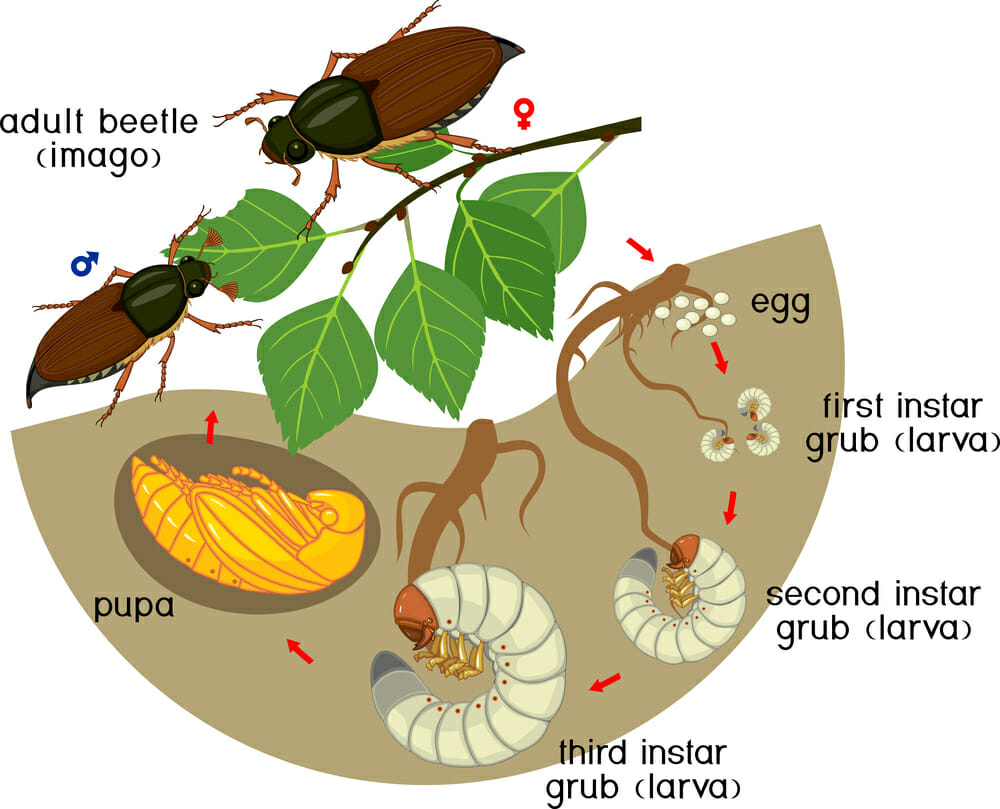
Diagnosing a Grub Infestation
If you suspect you have a grub infestation, there are a few simple steps you can take to confirm. First, pull back a section of the damaged lawn to see if the roots have been eaten away. If grubs are the cause, the grass may pull up like a section of carpet. Another method is to use a shovel to dig up a square foot of grass and soil, then examine the soil for grubs. A healthy lawn should have no more than 10 grubs per square foot. Check for beetle eggs as well since this is a sign of a coming infestation. Remember those eggs hatch in two weeks!
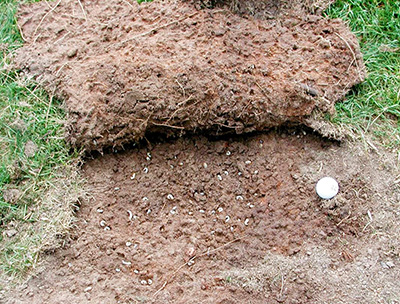
Application Timing
The most important factor when treating grubs is timing. To effectively control grubs, treatment of a systemic product like imidacloprid should be applied in the Summer, when the grubs are young and actively feeding on the roots of your lawn. Young grubs are much more susceptible to pesticides. The ideal time for treatment of a kill-on-contact like bifenthrin is after all the season’s larvae have hatched, which typically occurs in late August to early September. This maximizes the number of available grubs you can kill with a single application. However, don’t wait for the weather to get cold. As temps cool down, grubs migrate deeper into the soil in preparation for winter. Once they’re deep enough, pesticides can’t reach them.
Types of Grub Control Insecticides
Before we go over the best grub killer, it’s important you know the difference between the two main types of grub killers, contact and systemic.
Contact insecticides
These kill on contact. The advantage here is that they work quickly to kill the target insect. The downside is they tend to be more toxic than their systemic counterparts and they only last a short time in the soil.
Systemic insecticides
Systemics work by being absorbed by the target insect’s food source. The plant takes up the systemic, then, when the grubs feed they ingest the product and die. Systemics tend to be much less toxic than contact insecticides. They last much longer but take some time after being applied to be absorbed by the plants and start killing the grubs. We recommend systemic grub killers.
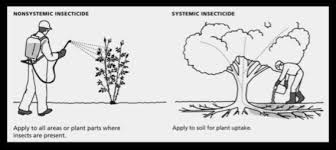
Best Grub Killers
There are several chemical options available for controlling grubs, each with its own pros and cons. Here are a few of the most common options:
Imidacloprid: This is a systemic insecticide that is absorbed into the roots of the grass and then moves up into the shoots and foliage, providing protection from grubs. Imidacloprid is highly effective and long-lasting, providing up to 4 months of control. One of the benefits of imidacloprid is that it is safe for use around pets and wildlife, and is not harmful to beneficial insects. We consider imidacloprid to be the overall best grub killer.
Chlorantraniliprole: This is another systemic insecticide that is absorbed into the roots of the grass and then moves up into the shoots and foliage, providing protection from grubs. Chlorantraniliprole is highly effective and long-lasting, providing up to 4 months of control. One of the benefits of chlorantraniliprole is that it is safe for use around pets and wildlife, and is not harmful to beneficial insects.
Bifenthrin: This is a contact insecticide that is applied to the surface of the soil and then moves down to the grubs. Bifenthrin is highly effective, providing up to one month of control, but it is toxic to beneficial insects and should not be used around pets or wildlife. We do not generally recommend bifenthrin for grub control.
Trichlorfon: One of the benefits of this contact insecticide is that it is effective against a wide range of insect pests, not just grubs. It is also relatively fast-acting, providing quick relief from a grub infestation. Like bifenthrin, it is toxic to a wide range of insects and animals. Trichlorfon does not offer extended control for grubs.
Step-by-Step Guide for Applying a Granular Grub Control Product
Here’s a step-by-step guide for applying a granular grub control product:
- Time your application for the type of product your using.
- Mow your lawn and remove any clippings to ensure an even application. Tall grass can prevent granules from reaching the soil.
- Calculate the amount of product you’ll need based on the size of your lawn from the recommended application rate on the packaging.
- Apply the product evenly over the entire lawn using a broadcast spreader. Make sure to follow the manufacturer’s instructions for application rate and coverage.
- Water the lawn thoroughly to help the insecticide penetrate the soil.
- Avoid mowing or heavy foot traffic on the lawn for at least 24 hours after applying the imidacloprid to allow it time to absorb into the soil.
In conclusion, grubs can cause significant damage to fescue grass lawns in the transition zone. To effectively control grubs, it’s important to understand their life cycle and the best timing of treatment. There are several chemical options available for grub control, each with its own pros and cons. If you decide to use imidacloprid, follow the step-by-step guide outlined in this article for the best results. Always follow the manufacturer’s directions. With proper treatment and care, your lawn can stay grub-free and healthy for years to come.
Want a professional to use the safest and best grub killer on your lawn? Click here to get an estimate from Midwest Turf Pros.
